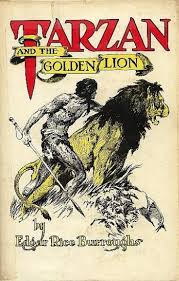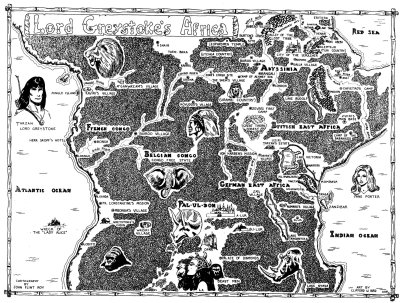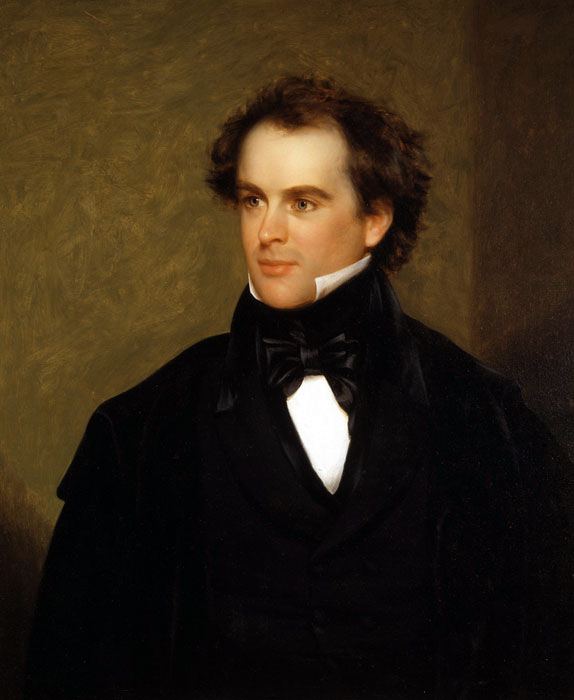 With Tarzan and the Golden Lion, Burroughs has taken his most famous creation about as far from his original conception as he could probably get it. (So far, anyway.) Whereas Tarzan of the Apes was a kind of Victorian romance a la Kipling, this ninth volume has our hero rushing head-long into unabashed Howard-esque pulp. Not only does he take us back to the lost kingdom of Opar, but he also plunges us into another, even more fascinating one. There’s an okay deception plot that involves a Tarzan look-a-like, and lots-o-stereotyped characters (some uncomfortably so). And there’s a trained lion – hence the title. Burroughs is definitely plaed on his strengths here – his rich imagination. While not without flaws, this book is definitely one worth reading.
With Tarzan and the Golden Lion, Burroughs has taken his most famous creation about as far from his original conception as he could probably get it. (So far, anyway.) Whereas Tarzan of the Apes was a kind of Victorian romance a la Kipling, this ninth volume has our hero rushing head-long into unabashed Howard-esque pulp. Not only does he take us back to the lost kingdom of Opar, but he also plunges us into another, even more fascinating one. There’s an okay deception plot that involves a Tarzan look-a-like, and lots-o-stereotyped characters (some uncomfortably so). And there’s a trained lion – hence the title. Burroughs is definitely plaed on his strengths here – his rich imagination. While not without flaws, this book is definitely one worth reading.
Okay, here’s what a liked (along with some SPOILERS):
The Valley of the Diamond: This was incredible. I adored the lost world in the last book: the mysterious land, the swamps, the city. But there was something about this one that really spoke to me. I think it was the description of the city itself which reminded me of passages from the early John Carter books. Africa is presented as a fantastic realm, and it works perfectly within the pulp genre.
Here’s a sample:
The building within the enclosure was of great size, its different parts appearing to have been constructed at various periods, and each with utter disregard to uniformity, resulting in a conglomeration of connecting buildings and towers, no two of which were alike, though the whole presented a rather pleasing, if somewhat bizarre appearance. The building stood upon an artificial elevation about ten feet high, surrounded by a retaining wall of granite, a wide staircase leading to the ground level below. About the building were shrubbery and trees, some of the latter appearing to be of great antiquity, while one enormous tower was almost entirely covered by ivy. By far the most remarkable feature of the building, however, lay in its rich and barbaric ornamentation. Set into the polished granite of which it was composed was an intricate mosaic of gold and diamonds; glittering stones in countless thousands scintillated from facades, minarets, domes, and towers.
 I also stumbled upon a map on the net that shows the locations of many of the lost civilizations Tarzan encounters, which only adds to the fantasy elements to these tales – just like every other modern fantasy book you open. This one has art by Clifford Bird, and it is marvelous.
I also stumbled upon a map on the net that shows the locations of many of the lost civilizations Tarzan encounters, which only adds to the fantasy elements to these tales – just like every other modern fantasy book you open. This one has art by Clifford Bird, and it is marvelous.
A Race of Intelligent Gorillas: The lost civilization in the last book was great with its monkey-men and all, but this time out, we have city of intelligent gorillas who use humans as slaves. I couldn’t help but wonder what role, if any, that these chapters played in the origins of Grodd and the city of super-intelligent apes in DC comics. These weren’t like Grodd but it was a nice planet-of-the-apish reversal and seemed very appropriate for the Lord of the Jungle to encounter.
Jad-bal-ja, the Golden Lion: Finally! Tarzan’s cruelty streak is gone. And for once, instead of killing a pride of lions, he nurtures and trains one. The lion made a magnificent faithful companion, and I do hope to see more of him in later volumes.
And my didn’t likes:
The Stereotypes: The Europeans were about as stereotypical as you could get. They actually resembled bad caricatures more so than characters in a way. I found this quite uncomfortable at times, while I suppose they were supposed to be funny, I found them embarrassing.
But they were as uncomfortable as what’s next.
Racism: It raised its vile head again. Mostly in the language and actions of the Europeans. I suppose some will claim it was the time in which the story took place or even the times in which Burroughs wrote. Does that make it right either way? That’s a tough call, because while I will go on record as saying The Adventures of Huckleberry Finn is one of the greatest American novels written, the exaggerated characterization and the language in this book made me cringe at times. But that’s a whole other debate.
Tarzan and the Golden Lion was by far my favorite so far, despite its flaws. Here Tarzan has reached the epitome, if not surpassed, Burroughs’s other pulp creations. Tarzan is John Carter of Africa ; he is David Innes. Burroughs has dropped many of the “savage” characteristics that he introduced in the first volume. As the stories became more pulp, however, they do seem more out of place. The Lord of the Jungle emerges in these middle volumes, one that is more like a sword-sorcery hero. His nobility and code of honor distinguish him within Burroughs’s jungle world, which has become just as fantastical and mysterious as Howard’s Hyperborea or even Burrough’s own Barsoom or Pellucidar. This is the Tarzan that most media seems to have been based upon, and I’m good with that. I like this Tarzan best.
I’m going to take November off for NaNoWriMo. I’ll be picking up volume 10, Tarzan and the Ant Men, toward the later part of the month probably, so I’ll be posting in mid to late December. Feel free to leave comments or throw a topic in to discuss. I do believe there’s lots here –good, bad, and ugly – worthy of it.
See you soon!
 Sunday, November 23, 2014 at 07:53PM
Sunday, November 23, 2014 at 07:53PM  H.G. Wells,
H.G. Wells,  Science Fiction quotes,
Science Fiction quotes,  The Time Machine in
The Time Machine in  Quotes
Quotes 


